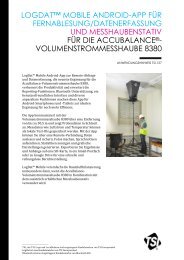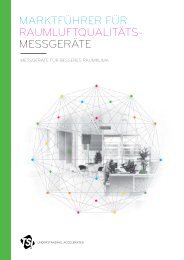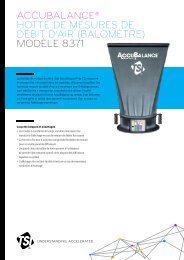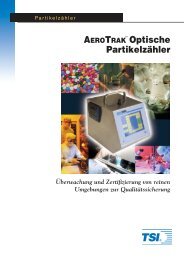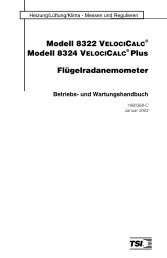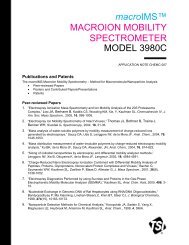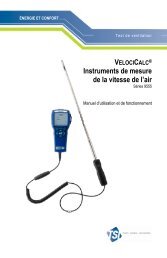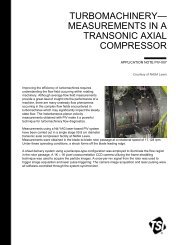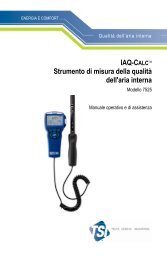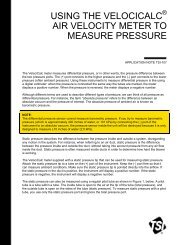AEROSOL DILUTER MODEL 3302A - Tsi
AEROSOL DILUTER MODEL 3302A - Tsi
AEROSOL DILUTER MODEL 3302A - Tsi
You also want an ePaper? Increase the reach of your titles
YUMPU automatically turns print PDFs into web optimized ePapers that Google loves.
<strong>AEROSOL</strong> <strong>DILUTER</strong><br />
<strong>MODEL</strong> <strong>3302A</strong><br />
AN <strong>AEROSOL</strong> <strong>DILUTER</strong> FOR TSI’S<br />
AERODYNAMIC PARTICLE SIZER®<br />
(APS) SPECTROMETERS.<br />
The Aerosol Diluter Model <strong>3302A</strong> interfaces di rectly with TSI Aerodynamic<br />
Particle Sizer® (APS) spectrometers. It re duces particle concentrations in<br />
high-concentration aerosols, providing researchers with a representative<br />
sam ple that meets the recommended operational re quire ments for these<br />
high-resolution time-of-flight spectrometers.<br />
The Aerosol Diluter Model <strong>3302A</strong> uses a closed system of operation.<br />
It isolates a small sample of particles in an aerosol flow and reunites it<br />
with filtered, “clean” gas from the same original aerosol. This eliminates<br />
the effects of in troducing unknown gas characteristics such as<br />
temperature, pressure, relative humidity, or elemental makeup into the<br />
aerosol. The <strong>3302A</strong> minimizes particle loss during the dilution process<br />
by constantly transporting the aerosol sample in a downward direction<br />
and optimizing the geometry of the flow path. This helps reduce<br />
particle losses due to sedimentation and turbulent deposition, and<br />
provides a sample that is highly representative of the original aerosol.<br />
The diluter outlet mates directly with the spectrometer* inlet for<br />
on-line dilution and analysis of high-concentration aerosols. Because<br />
aerosol introduced for dilution is drawn through the Model <strong>3302A</strong> by<br />
the spectrometer, the diluter requires no power or compressed gas.<br />
* Model <strong>3302A</strong> works with all APS spectrometers. However, TSI recommends the earlier<br />
Model 3302 for use with Models 3300, 3310, and 3310A.<br />
UNDERSTANDING, ACCELERATED<br />
Applications<br />
+ APS accessory<br />
Features and Benefits<br />
+ Standard dilution ratios of 100 to 1 and 20 to 1 (two diluters<br />
may be used in tandem for ratios up to 10,000 to 1)<br />
+ Very low particle loss in the 0.5- to 10 μm size range<br />
+ Highly repeatable performance<br />
+ Original aerosol’s gas characteristics maintained<br />
during operation<br />
+ Totally self-contained design<br />
+ No outside power or compressed-gas requirements<br />
+ Durable, rugged construction<br />
+ Simple maintenance procedures<br />
+ Dual pressure gauges (indicate correct operation or signal<br />
need for maintenance)
SPECIFICATIONS<br />
<strong>AEROSOL</strong> <strong>DILUTER</strong><br />
<strong>MODEL</strong> <strong>3302A</strong><br />
Operation<br />
Aerosol is drawn through the diluter by the time-of-flight<br />
spectrometer at a total flow rate of 5 liters per minute. Upon<br />
entering the diluter inlet, the concentrated aerosol flow divides<br />
into two paths. In one path, the majority of the original aerosol is<br />
cleansed of virtually all particles. In the other, the remaining small<br />
fraction of the aerosol retains its particle concentration. These two<br />
paths then re-combine to produce the desired dilution.<br />
Inside the Model <strong>3302A</strong> (using a 100-to-1 capillary)<br />
1. At the point where the original aerosol flow path is split in<br />
two, a flow of 0.05 liter per minute enters a capillary tube<br />
isokinetically and passes through.<br />
2. The remaining 4.95 liters per minute of aerosol travels<br />
through a high-efficiency particulate air (HEPA) filter<br />
where particles are removed. †<br />
3. The filtered portion of the gas flow then recombines with<br />
the aerosol flow released from the capillary tube, achieving a<br />
100-to-1 dilution ratio of the original aerosol. ‡ A mixing cone<br />
ensures a uniform distribution in the diluted aerosol.<br />
4. Well-mixed, diluted aerosol exits the Model <strong>3302A</strong> and enters<br />
the APS spectrometer.<br />
5. The aerosol-path ∆P gauge measures flow through the capillary.<br />
The total ∆P gauge measures pressure drop across the whole<br />
system. This two-gauge ap proach allows detection of conditions<br />
like a clogged capillary, loaded filter, or leak in the instrument.<br />
6. To obtain the correct dilution ratio, the operator simply adjusts<br />
the regulating valve until the de sired reading is indicated on the<br />
aerosol-path-∆P gauge.<br />
The manifold and filters require periodic maintenance as<br />
particles are deposited continually during repeated dilution<br />
procedures. Flow paths and internal components are designed<br />
for easy, trouble-free cleaning. This highly human-engineered<br />
instrument can be serviced in less than one-half hour by an<br />
experienced operator.<br />
2<br />
High-Eciency<br />
Filters<br />
6<br />
DP Adjust<br />
UNDERSTANDING, ACCELERATED<br />
TSI Incorporated - Visit our website www.tsi.com for more information.<br />
USA Tel: +1 800 874 2811<br />
UK Tel: +44 149 4 459200<br />
France Tel: +33 4 91 11 87 64<br />
Germany Tel: +49 241 523030<br />
P/N 1930094 RevB ©2012 TSI Incorporated<br />
1<br />
3<br />
4<br />
Inlet<br />
Outlet<br />
Capillary<br />
Aerosol<br />
Path DP<br />
5<br />
Total DP<br />
India Tel: +91 80 67877200<br />
China Tel: +86 10 8251 6588<br />
Singapore Tel: +65 6595 6388<br />
Printed in U.S.A.<br />
Dilution Ratio<br />
100:1 and 20:1 standard<br />
Flow Rate<br />
5 L/min total flow (drawn by APS spectrometer)<br />
Particle Size Range<br />
2 to 100 nm<br />
Penetration Efficiency<br />
>93% for respirable particles, lower efficiency can be expected<br />
for larger particles (efficiency correction curves are built into the<br />
spectrometer software)<br />
Pressure Drop<br />
Approximately 1.2 cm H 2O (0.47 in. H 2O) total<br />
Construction Materials<br />
Anodized aluminum, stainless steel, Buna-N, fiberglass, nylon<br />
Power and Compressed-air Requirements<br />
None (flow created by APS spectrometer)<br />
Dimensions (L x W x H)<br />
28 cm x 37 cm x 22 cm (11 in. x 14.5 in. x 8.5 in.)<br />
Weight<br />
5.9 kg (13 lbs)<br />
TO ORDER<br />
Aerosol Diluter<br />
Specify Description<br />
<strong>3302A</strong> Aerosol Diluter<br />
The Model <strong>3302A</strong> interfaces easily with Model 3320 and 3321<br />
APS spectrometers. The spectrometer, which creates the flow<br />
through the diluter, must be ordered separately.<br />
† The manufacturer’s rating of HEPA filters in the diluter is less than 0.03% penetration<br />
for particles of 0.3-micrometer diameter. Performance tests done by TSI Incorporated<br />
indicate actual penetrations less than 0.001%.<br />
‡ A 20-to-1 dilution ratio is achieved by changing the capillary-tube assembly.<br />
This combines 4.75 liters per minute of cleansed aerosol with 0.25 liter per minute<br />
of original aerosol.<br />
Specifications are subject to change without notice.<br />
Aerodynamic Particle Sizer, TSI and the TSI logo are registered trademarks, and APS is a<br />
trademark of TSI Incorporated.



